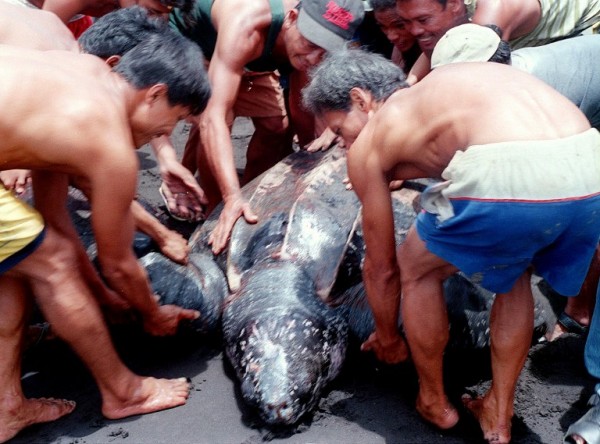LEGAZPI CITY, Albay, Philippines – All of the 90 eggs laid by a giant leatherback turtle on the shore of a coastal village here last July failed to hatch within the normal 70-day period, a wildlife specialist of the Department of Environment and Natural Resources said Thursday.
Nilo Ramoso, officer of the DENR Pawikan Conservation Project, said the failure of the eggs to hatch was due to contamination with salt water following salt water seepage into the original nest site near the mouth of the Yawa River in Legazpi’s Rawis village.
Ramoso said that despite measures taken to protect the eggs from predators, such as carefully transferring the eggs a few meters inland, “It was unfortunate all the eggs failed to develop into hatchlings.”
He said the real culprit was the salt water that contaminated the eggs when the mother turtle entered the nesting site along the Yawa River during high tide.
Seventy of the 90 eggs that underwent laboratory test were in an “embryonic mortality stage,” meaning the embryos of the eggs were dead, he said.
He said laboratory findings revealed that the embryos or egg yolks and their albumin were contaminated with salt water, preventing them from maturing.
Ramoso said the 70 eggs that were examined were buried back Thursday at the nesting site off the Philippine Navy camp in Rawis village, while the 20 remaining eggs would be preserved and used as exhibits during lectures and conservation campaigns.
A two-meter-long leatherback turtle weighing between 250 and 300 kilos laid the eggs on the bank of Yawa River on July 19. DENR personnel led by marine biologist Angie Veloria later transferred the eggs to a new site on the beach near the PN regional headquarters.
The marine biologist, after securing the turtle eggs, dug a half-a-meter-deep hole in the sand and with sand taken from the original nesting site buried the eggs. The site was protected with a perimeter fence with plastic screen.
The transfer was meant to protect the eggs from being washed away during high tide and from predators such as dogs and cats, or even people.
Leatherback turtles (Deomchelys coriacea) are the largest marine turtles in the world. They are considered endangered species.
Giant turtles normally lay 50 to 110 eggs and it takes 45 to 70 before hatchlings emerge.
The mother turtle that was released back to the sea on July 20 was expected to have returned after two weeks but this never took place, said Ramoso, who conducted on Aug. 5 to 9 a site inspection of possible places the turtle might have returned to.
DENR records showed that the arrival here of the leatherback turtle last July was the third sighting in Bicol. The first was in 1980 when a dead giant turtle was found by fishermen. The second sighting happened in 2012 at the coast of Ragay in Camarines Sur, with the leatherback turtle immediately released back to the sea.
Ramoso said the leatherback turtle’s laying of eggs in this city was the first recorded turtle nesting event not just in Bicol but in the country.
